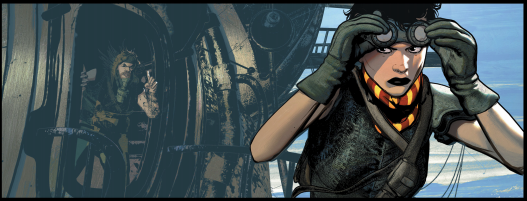Sonata #12 // Review
According to veteran comics writer Larry Hama, at some point in the early 1980s, a yet-to-be-published installment of his G.I. Joe had gone missing at Marvel. Having to meet a very tight deadline, Hama scrambled to write an issue that would feature no dialogue or captions to make a deadline by bypassing the comic book's lettering stage. 1984's G.I. Joe #21 wasn't the only "silent" issue of a comic book, but it was easily the most influential, inspiring creative teams to occasionally try their hands at something similar. Writer David Hine and artist Brian Haberlin celebrate the "silent comic" format with the Sonata #12: a standalone story for their fantasy series. Hine's narrative specifics fade into an appealing background, allowing Haberlin's art to render the entire story in an appealing interlude for the series.
The issue is set before the beginning of the series. Sonata meets her hulking companion Treen for the first time. Sonata embarks on a little bit of flight on the back of her avian steed only to find herself chased by a titanic bird of enormous proportions. A chase ensues. What at first appears to be a greater threat turns into something else entirely as Treen saves the lives of Sonata and her steed. Victory is short-lived, however, as both Treen and Sonata find themselves cast into a danger that threatens them both.
Hine does a pretty good job of delivering a story with almost no text. There's an introduction that states the prequel nature of the story. Still, aside from that and a couple of punctuation-as-dialogue instances and some sound effects, this is a totally nonverbal issue. The basic characterization is there, in a story that features a visceral sense of action. Pages flit briskly through the first meeting of Sonata and Treen. There isn't a whole lot of depth in the story that's delivered. Sadly, there isn't much in the encounter that feels like it's adding very much to the ongoing narrative of the series. The story feels extraneous.
Haberlin is given the entirety of every panel, and he does a really good job with it. There's an epic stillness to every page, which is honestly a bit odd for an issue that allows the artist to really dazzle with fluid motion of action from panel to panel. There are only a couple of panels that give a sense of breathtaking motion...which really SHOULD be more prominent in what is essentially an issue-length pursuit. What the issue's impact lacks in explosive action, it partially makes up for in emotion and perspective. Drama plays out in intricacies on the faces of Sonata and Treen. Haberlin showcases his distinctive contrast between relatively small humanoids and the immensity of the world in which they exist without any text other than sound effects. The immensity of the world of Sonata feels like almost enough to carry the entire issue.
This is a move in the right direction for a fantasy series struggling to find its distinctive voice. The mishmash of traditional fantasy with science fiction and steampunk iconography hasn't quite gelled into anything totally coherent yet. Nonetheless, Sonata herself continues to be appealing enough to return to every month.
Grade: B










